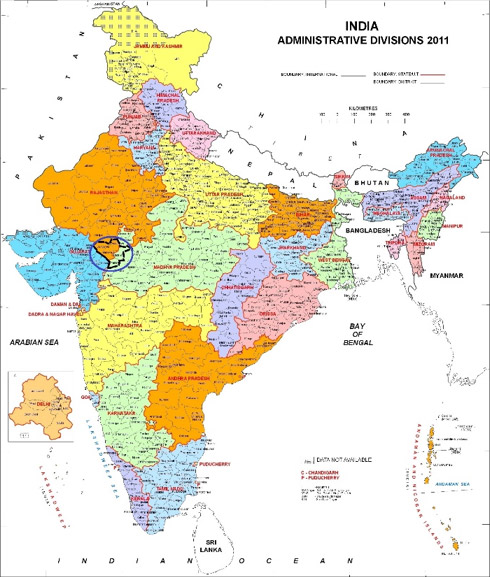COVID-19 Response: Kharif Bachao Abhiyaan
Indigenous Community in Central-Western India
Nearly 8% of the Indian population belongs to the indigenous tribal community. Most of these indigenous people live in peripheries of the forests. Traditionally they were following nature-friendly livelihoods maintaining the ecological balance. Most of the land belonging to these families is undulation, sloping with low soil depth. The majority of small and marginal indigenous farmers supported subsistence agriculture dependent on rains. Once the rainy season is over moisture level in such area reduced thus affecting employment opportunity also. We can say Kharif season is the cropping season for these families. This cropping season provides them food security in terms of cereals, pulses, green vegetables and some oil-seeds.
Moreover, state-level development policies do not create in-situ employment opportunities in these areas. Consequently, most of them do not get sufficient work opportunities beyond monsoon. It results in migration of the working population from these families to urban centers like Ahmedabad, Surat, Rajkot, Mumbai, Indore, Pune, etc.
Thus, one finds that the seasonal migration of youth from this rain-fed agriculture areas is mostly distress driven. This year also, an average of 25-30 youth from the majority of villages migrates to metros after celebrating the festival of Holi. Unfortunately, this year only 8-10 days had passed, following the COVID-19 pandemic, a nation-wide lockdown was declared by the honourable prime-minister on 24th of March 2020. Like all others, these tribal who had just arrived and started their jobs were shocked. Whatever they brought from home was near to complete, a new source for income was blocked; thus, most of them were in a dilemma of what to do? Where to go? They were worried about the immediate future and long-term livelihood.
A large number of youths preferred to come back and started returned journeys. A large number walked, while some were lucky enough to get facilities like buses, trucks, lorry, tempo, of-course at a very high cost. By the end of April 2020, nearly half a million youth came back to this juncture of the states of Gujarat, Madhya-Pradesh, and Rajasthan. Somehow, they reached home and feeling safe, but a large number of them shocked due to this situation. These youth, their elders, and other family members are undergoing turmoil. Most likely this year nearly half of these youth who have returned due to COVID-19 spread may not go back. On the one hand, lockdown resulted in a loss of employment opportunities for nearly 35-45% of households. They believe that lockdown might affect the operation of industries, thus there may be limited opportunities in metros.
Thus, the only option remains for tribal communities in this region is that of concentrating more on agriculture and allied activities, that too mainly for own consumption. Cropping season for Kharif-2020 is already started, and monsoon might arrive in the next six-seven weeks-time. Akshaya-Tritiya, which marks the start of agriculture-calendar for the year, has already passed two-weeks now, but farmer's preparatory action is not visible. It may be a threat to the forthcoming agriculture season. It might result in non-sowing of the about nearly 40000-hectare area during the Kharif-2020. It will result in loss of cropping season for these small and marginal families, causing food insecurity for 500000 indigenous people.
VAAGDHARA recognized the gravity of the situation, which may cause a condition of chronic poverty for these already vulnerable families. In the last week of April 2020, we organized rounds of discussions with tribal farmers and leaders. During these discussions, most of the farmers have indicated that they do not have quality seeds, manure, fertilizers, labor, market, and cash. Their youth, who went to cities to work there, to arrange cash income for all these preparations, are back without money. They also said that their resources are dried-up, and hope for credit is negligible. They do not have sufficient cash to procure seed, prepare fields, buy manure, etc. Thus, there is no way instead of keeping these lands un-cultivated. If it happens like this, in the memories of farmers, VAAGDHARA, and perhaps we all, probably it will be “the first time that a considerable number of farmers leave their field un-cultivated, due to lack of sufficient resources".
It is a precarious situation that agriculture, which is the largest occupation provider in India, is facing a threat. It is not the question on one season of the crop, and instead, it is the matter of trust in agriculture. VAAGDHARA believes that if civil society does not take appropriate, timely steps, well-meaning individuals and institutions, we may witness another pandemic in terms of nutrition insecurity for small and marginal indigenous communities.
It may be a big task for a family to generate resources to cultivate his one to two-acre land, jointly it is achievable to take-up farming in 40000 hectares and support 100000 families. It is time that we all join hands and show our solidarity to small and marginal farmers of the indigenous community. VAAGDHARA worked with some advanced farmers and designed a package that can help in saving Kharif crop covering an acre land and fulfilling most of the requirements of a small family of five-six members. Critical input support of Rs.2000, cultivation labor by a farmer family, 15 days support from Government under MNREGA, regular motivation from VAAGDHARA team will be sufficient to saving Kharif crop in one-acre land. The designed support for each family will be multi-purpose (Figure-1), resulting in the sustainability of livelihood for the long-term.
This amount will help to provide the required seed and seedlings, fertilizers, and minor implements. Though the step is to a save-Kharif crop, it will lay a foundation for the sustainability of rainfed farming in this region; Figure-2 shows the anticipated results.
Rs.2000 SUPPORT FROM YOU
Seed & Seedlings
Manure
Motivation
Minor implements
RESULT OF YOUR SUPPORT
Food for Eight Months
Nutritive vegetables
Medicinal Plants
Fruit Plants
VAAGDHARA has initiated this campaign “Save Kharif-2020 to Save Marginal Farmers”. The ultimate objective of this campaign is “To help 100000 indigenous farmer families in for taking-up Kharif cropping” while doing so, we will also be able to restore the importance of agriculture and lay a foundation for protecting the culture of solidarity. While helping these families to get prepared to make effective use of Kharif season VAAGDHARA will also incorporate long term vision of the self-dependency of these communities on nutrition and health aspects. Therefore, the focus will be on long-term sustainability reviving and rejuvenating nutrition-sensitive farming systems. Each family will be motivated and supported to cultivate with the basics of “Family first” and establish a perennial kitchen garden. There is a big list of local nutritional plants and crops, but the medicinal plants are commonly not frequently found in homestead gardens. VGGAHDRA will also provide saplings and seeds for plants that can be used to tackle common ailments and strengthen the immune system. Common medicinal plants will be Vakas, Kalpanath, Tulasi, Pathar-Chatta, Sadabahar, Musali, Ashwagandha, Aparajeeta, Giloy, etc.
On one hand, the campaign will result in ensuring nutrition security for 100000 families (500000 individuals) and making them resilient against the common diseases and infections.
This campaign is to generate support for 100000 families for seed, fruit plant saplings, plantation, protection, and hand-holding guidance. This action will help us to ensure farming during the Kharif season for at least 40000 hectares. Support of Rs.2000 to a family will help him/her in cultivating at least 1 acre (0.4 hectares) and making their family self-dependent account of food-grain. With this support, farmers will move from most-vulnerable to the status of most-resilient of a pandemic like that of COVID-19.








